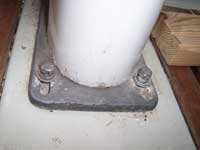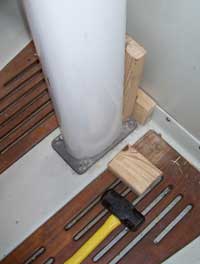Sailboat Rigging: Adjusting the Rake
Any sailmaker's tuning guide will specify a mast rake and other measurements that depend on the location of your mast step. Here's a safe way to move it forward or aft.
There aren’t many times when a sledgehammer becomes the preferred fine adjustment tool on a boat, but it seemed to be the right choice for moving our mast just after our boat went in the water. When starting to race with a new boat, I’m a firm, principled believer in surrendering all of your principles and beliefs - and shamelessly copying the setup that is proven. Once you rise to the top of the class you can be an innovator, but the first step is to set up the boat based on the accepted measurements.

Changes in rake can be hard to spot from off the boat, but they make all the difference in boat speed and feel.
I arrived at the boat armed with the North Sails tuning guide, which prescribed a forestay length, a “J” measurement (from the stemhead at the bow to the front of the mast), and an amount of prebend (forward bend in the mast as you sight up the aft face) to start with at the dock.

Step one: loosen the bolts holding the step into the keel.
We had already realized the forestay was too short. A Harken roller furler had been added to the boat, and it appeared that the forestay had been cut to allow the furler and foil to be installed, and then reheaded with a new end fitting. This shortened the forestay by the amount of rod captive in the fitting that was removed. After adding an extra toggle to the forestay we were still slightly short, but within the range of adjustment for light to heavy air. It would have to do.

Step two: "persuade" wedges to fit between mast and bulkhead, gradually easing the butt forward.
As the mast sat in the boat with our lengthened forestay, the “J” measurement was too large (it was hard against the aft wall of the mast collar at the deck), and it still had way too much prebend – so the mast butt clearly needed to move forward.
This would have been nice to know before the mast went in, but there it was, and now I had to move it. The challenge was that the weight of the mast and rigging, plus any rig tension, was all creating compression on the mast step.
We had faced a similar situation in 2004 on our old boat. I put a line around the mast at deck level, led it forward to a snatch block and back to a winch, eased off all the rig tension, loosened the bolts holding the mast step, and used a 2x4 as a lever to push the mast butt forward. The result was a huge BANG! as the step shot forward until the bolts hit the end of the adjustment slots in the step. I’m lucky I didn’t shear them right off.

Thanks to fine-tuning with the sledgehammer, the mast butt is now max forward.
I wasn’t eager to repeat that little explosion, so this time I loosened the bolts, eased the backstay off, and used a couple of small 2 x 4 pieces and some paint sticks to wedge the mast forward. The sledgehammer persuaded the wood to slide into place, moving the mast gradually forward. It was loud too, but not nearly as dramatic—and it worked.
The biggest danger was in breaking the bulkhead or the fiberglass pan in the head compartment where the lowest piece of wood pressed against it. Fortunately, that didn’t happen – further confirming the “brick house” status of a J/35.
Editor's Note: This article is part of an ongoing series on used boat repairs. Previous posts include:
To Buy a Boat or Not to Buy a Boat
Used Boat Ads
How to Talk with the Broker
Looking at the Boat
Reaching an Agreement
Choosing a Name
Keel Repair and Fairing
Working with Boatyards
Rigging Your Mast
 Paul Grimes is an engineer and marine surveyor living in Portsmouth, RI. For more information, visit the Grimes Yacht Services website.
Paul Grimes is an engineer and marine surveyor living in Portsmouth, RI. For more information, visit the Grimes Yacht Services website.












